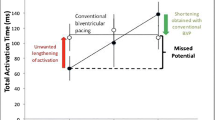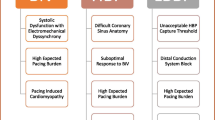Abstract
Purpose of Review
His bundle pacing (HBP) is gaining popularity as a therapy for cardiac conduction disease. Utilization of the conduction system with HBP avoids the adverse effects of right ventricular pacing (RVP). Improvements in left ventricular (LV) function, New York Heart Association (NYHA) functional class, and quality of life (QOL) accompanying physiological activation induced by HBP attract attention. This is particularly important given the 30% non-responder rate from cardiac resynchronization therapy (CRT) studies; large number of patients with or at risk for pacing-induced cardiomyopathy and patients with poor coronary sinus (CS) targets.
Recent Findings
The advantages of HBP as an alternative method for resynchronizing failing ventricles are supported by several recent studies, which are detailed in this review. HBP had significant clinical benefits in terms of LV ejection fraction (LVEF), NYHA functional class, and diuretic use. A growing number of case reports from several centers also support this growing trend. Additionally, success rates of in correcting bundle branch block have been reported in a number of studies and appear similar to traditional BiV pacing.
Summary
HBP is an attractive alternative to CRT in patients with heart failure and electrical conduction abnormalities. With improvements in guide-catheter design, lead structure, and overall operator experience, increased use and improved outcomes are expected in the next decade.




Similar content being viewed by others
References
Papers of particular interest, published recently, have been highlighted as: •• Of major importance
Bleeker GB, Schalij MJ, Molhoek SG, Verwey HF, Holman ER, Boersma E, et al. Relationship between QRS duration and left ventricular dyssynchrony in patients with end-stage heart failure. J Cardiovasc Electrophysiol. 2004;15(5):544–9.
Bristow MR, Saxon LA, Boehmer J, Krueger S, Kass DA, De Marco T, et al. Cardiac-resynchronization therapy with or without an implantable defibrillator in advanced chronic heart failure. N Engl J Med. 2004;350(21):2140–50.
Cleland JG, Daubert JC, Erdmann E, Freemantle N, Gras D, Kappenberger L, et al. The effect of cardiac resynchronization on morbidity and mortality in heart failure. N Engl J Med. 2005;352(15):1539–49.
Moss AJ, Hall WJ, Cannom DS, Klein H, Brown MW, Daubert JP, et al. Cardiac-resynchronization therapy for the prevention of heart-failure events. N Engl J Med. 2009;361(14):1329–38.
Yu CM, Hayes DL. Cardiac resynchronization therapy: state of the art 2013. Eur Heart J. 2013;34(19):1396–403.
Vijayaraman P, Dandamudi G, Herweg B, Sharma P, Ellenbogen K. Permanent His bundle pacing is an excellent alternative to cardiac resynchronization therapy. Heart Rhythm. 2016;13:S39.
Barba-Pichardo R, Manovel Sanchez A, Fernandez-Gomez JM, Morina-Vazquez P, Venegas-Gamero J, Herrera-Carranza M. Ventricular resynchronization therapy by direct His-bundle pacing using an internal cardioverter defibrillator. Europace. 2013;15(1):83–8.
Ajijola OA, Macias C, Garg V, Vorobiof G, Mally AH, Shivkumar K, et al. Feasibility of His bundle pacing in patients meeting criteria for cardiac resynchronization therapy and implantable cardioverter-defibrillator. Circulation. 2015;132:A20082.
Wu G, Cai Y, Huang W, Su L. Hisian pacing restores cardiac function. J Electrocardiol. 2013;46(6):676–8.
Deshmukh P, Casavant DA, Romanyshyn M, Anderson K. Permanent, direct His-bundle pacing: a novel approach to cardiac pacing in patients with normal His-Purkinje activation. Circulation. 2000;101(8):869–77.
Wilkoff BL, Dual C, investigators VVIIDt. The Dual Chamber and VVI Implantable Defibrillator (DAVID) Trial: rationale, design, results, clinical implications and lessons for future trials. Card Electrophysiol Rev. 2003;7(4):468–72.
Sweeney MO, Hellkamp AS, Ellenbogen KA, Greenspon AJ, Freedman RA, Lee KL, et al. Adverse effect of ventricular pacing on heart failure and atrial fibrillation among patients with normal baseline QRS duration in a clinical trial of pacemaker therapy for sinus node dysfunction. Circulation. 2003;107(23):2932–7.
Lamas GA, Lee KL, Sweeney MO, Silverman R, Leon A, Yee R, et al. Ventricular pacing or dual-chamber pacing for sinus-node dysfunction. N Engl J Med. 2002;346(24):1854–62.
Sharma AD, Rizo-Patron C, Hallstrom AP, O’Neill GP, Rothbart S, Martins JB, et al. Percent right ventricular pacing predicts outcomes in the DAVID trial. Heart Rhythm. 2005;2(8):830–4.
Vijayaraman P, Dandamudi G, Lustgarten D, Ellenbogen KA. Permanent His bundle pacing: electrophysiological and echocardiographic observations from long-term follow-up. Pacing Clin Electrophysiol. 2017;40(7):883–91.
Occhetta E, Bortnik M, Magnani A, Francalacci G, Piccinino C, Plebani L, et al. Prevention of ventricular desynchronization by permanent para-Hisian pacing after atrioventricular node ablation in chronic atrial fibrillation. J Am Coll Cardiol. 2006;47(10):1938–45.
•• Huang W, Su L, Wu S, Xu L, Xiao F, Zhou X, et al. Benefits of permanent His bundle pacing combined with atrioventricular node ablation in atrial fibrillation patients with heart failure with both preserved and reduced left ventricular ejection fraction. J Am Heart Assoc. 2017;6(4):e005309. This study showed clinical outcomes of HBP for the patients with heart failure.
Sharma PS, Dandamudi G, Naperkowski A, Oren JW, Storm RH, Ellenbogen KA, et al. Permanent His-bundle pacing is feasible, safe, and superior to right ventricular pacing in routine clinical practice. Heart Rhythm. 2015;12(2):305–12.
Epstein AE, DiMarco JP, Ellenbogen KA, Estes NA 3rd, Freedman RA, Gettes LS, et al. 2012 ACCF/AHA/HRS focused update incorporated into the ACCF/AHA/HRS 2008 guidelines for device-based therapy of cardiac rhythm abnormalities: a report of the American College of Cardiology Foundation/American Heart Association Task Force on Practice Guidelines and the Heart Rhythm Society. Circulation. 2013;127(3):e283–352.
St John Sutton M, Plappert T, Adamson PB, Li P, Christman SA, Chung ES, et al. Left ventricular reverse remodeling with biventricular versus right ventricular pacing in patients with atrioventricular block and heart failure in the BLOCK HF trial. Circ Heart Fail. 2015;8(3):510–8.
Curtis AB, Worley SJ, Chung ES, Li P, Christman SA, St John Sutton M. Improvement in clinical outcomes with biventricular versus right ventricular pacing: the BLOCK HF Study. J Am Coll Cardiol. 2016;67(18):2148–57.
Zhang J, Zhang Y, Zhou X, Li J, Li Y, Zhang Y, et al. QRS duration shortening predicts left ventricular reverse remodelling in patients with dilated cardiomyopathy after cardiac resynchronization therapy. Acta Cardiol. 2015;70(3):307–13.
Mischke K, Knackstedt C, Fache K, Reith S, Rana O, Saygili E, et al. Electrical remodelling in cardiac resynchronization therapy: decrease in intrinsic QRS duration. Acta Cardiol. 2011;66(2):175–80.
Shan P, Su L, Chen X, Xu L, Ni X, Huang W. Direct His-bundle pacing improved left ventricular function and remodelling in a biventricular pacing nonresponder. Can J Cardiol. 2016;32(12):1577 e1–4.
•• Ajijola OA, Upadhyay GA, Macias C, Shivkumar K, Tung R. Permanent His-bundle pacing for cardiac resynchronization therapy: initial feasibility study in lieu of left ventricular lead. Heart Rhythm. 2017;14(9):1353–61. The authors showed the feasibility of HBP as an alternative to coronary sinus lead for the CRT indicated patients.
•• Sharma PS, Dandamudi G, Herweg B, Wilson D, Singh R, Naperkowski A, et al. Permanent His bundle pacing as an alternative to biventricular pacing for cardiac resynchronization therapy: a multi-center experience. Heart Rhythm. 2018;15(3):413–20. This paper evaluated the feasibility of HBP for the CRT indicated patients with failed left ventricular lead or nonresponder.
Barba-Pichardo R, Morina-Vazquez P, Fernandez-Gomez JM, Venegas-Gamero J, Herrera-Carranza M. Permanent His-bundle pacing: seeking physiological ventricular pacing. Europace. 2010;12(4):527–33.
Vijayaraman P, Naperkowski A, Ellenbogen KA, Dandamudi G. Electrophysiologic insights into site of atrioventricular block. JACC: Clin Electrophysiol. 2015;1(6):571–81.
•• Lustgarten DL, Crespo EM, Arkhipova-Jenkins I, Lobel R, Winget J, Koehler J, et al. His-bundle pacing versus biventricular pacing in cardiac resynchronization therapy patients: A crossover design comparison. Heart Rhythm. 2015;12(7):1548–57. This paper showed the clinical response of HBP as an alternative to traditional pacing method for the patients with CRT indication.
Su L, Xu L, Wu SJ, Huang WJ. Pacing and sensing optimization of permanent His-bundle pacing in cardiac resynchronization therapy/implantable cardioverter defibrillators patients: value of integrated bipolar configuration. Europace. 2016;18(9):1399–405.
Vijayaraman P, Ellenbogen KA, Dandamudi G. Longitudinal dissociation in the His bundle: persistent bundle branch block can be corrected by permanent His bundle pacing. Circulation. 2014;130:A17180.
Tung R. His bundle pacing versus coronary sinus pacing for cardiac resynchronization therapy (His-SYNC). Clinical Trials.gov. 2018. https://clinicaltrials.gov/ct2/show/study/NCT02700425. Accessed 18 Jan 2018.
Zachary W. The His Optimised Pacing Evaluation for Heart Failure Trial (HOPE-HF). Clinical Trials.gov. 2017. https://clinicaltrials.gov/ct2/show/record/NCT02671903. Accessed 5 Sep 2017.
Weijiang H. Comparison of His bundle pacing and bi-ventricular pacing in heart failure with atrial fibrillation. ClinicalTrials.Gov. 2017. https://clinicaltrials.gov/ct2/show/record/NCT02805465. Accessed 20 Jun 2016.
Kronborg MB, Mortensen PT, Poulsen SH, Gerdes JC, Jensen HK, Nielsen JC. His or para-His pacing preserves left ventricular function in atrioventricular block: a double-blind, randomized, crossover study. Europace. 2014;16(8):1189–96.
Occhetta E, Bortnik M, Marino P. Permanent parahisian pacing. Indian Pacing Electrophysiol J. 2007;7(2):110–25.
Zanon F, Svetlich C, Occhetta E, Catanzariti D, Cantu F, Padeletti L, et al. Safety and performance of a system specifically designed for selective site pacing. Pacing Clin Electrophysiol. 2011;34(3):339–47.
Vijayaraman P, Dandamudi G, Worsnick S, Ellenbogen KA. Acute His-bundle injury current during permanent his-bundle pacing predicts excellent pacing outcomes. Pacing Clin Electrophysiol. 2015;38(5):540–6.
Kawashima T, Sasaki H. A macroscopic anatomical investigation of atrioventricular bundle locational variation relative to the membranous part of the ventricular septum in elderly human hearts. Surg Radiol Anat. 2005;27(3):206–13.
Vijayaraman P, Dandamudi G. Anatomical approach to permanent His bundle pacing: optimizing His bundle capture. J Electrocardiol. 2016;49(5):649–57.
Cantu F, De Filippo P, Cardano P, De Luca A, Gavazzi A. Validation of criteria for selective His bundle and Para-Hisian permanent pacing. Pacing Clin Electrophysiol. 2006;29(12):1326–33.
DO W, BJ S, RR H, El-Sherif N, Lazzara R, Samet P. Selective versus non-selective His bundle pacing. Cardiovasc Res. 1976;10(1):91–100.
Vijayaraman P, Dandamudi G. How to perform permanent his bundle pacing: tips and tricks. Pacing Clin Electrophysiol. 2016;39(12):1298–304.
Chang JD, Manning WJ, Ebrille E, Zimetbaum PJ. Tricuspid valve dysfunction following pacemaker or cardioverter-defibrillator implantation. JACC. 2017;69(18):2331–41.
Vijayaraman P, Dandamudi G, Bauch T, Ellenbogen KA. Imaging evaluation of implantation site of permanent direct His bundle pacing lead. Heart Rhythm. 2014;11(3):529–30.
Mulpuru SK, Cha YM, Asirvatham SJ. Synchronous ventricular pacing with direct capture of the atrioventricular conduction system: functional anatomy, terminology, and challenges. Heart Rhythm. 2016;13:2237–46.
Sharma PS, Subzposh FA, Ellenbogen KA, Vijayaraman P. Permanent His-bundle pacing in patients with prosthetic cardiac valves. Heart Rhythm. 2017;14:59–64.
Vijayaraman P, Dandamudi G. Permanent His-bundle pacing: case studies. PACE. 2016;39:1305–12.
Kronborg MB, Poulsen SH, Mortensen PT, Nielsen JC. Left ventricular performance during para-His pacing in patients with high-grade atrioventricular block: an acute study. Europace. 2012;14(6):841–6.
Padala SK, Ellenbogen KA, Koneru JN. Intermittent loss of capture in a His bundle pacemaker: what is the cause? Heart Rhythm Case Rep. 2017;3:555–8.
Funding
This work was supported by a Nihon Kohden/St. Jude Medical Research Fellowship to KY and National Institutes of Health grants HL125730 and DP2HL 142045 to OAA.
Author information
Authors and Affiliations
Corresponding author
Ethics declarations
Conflict of Interest
Koji Yoshie, and Olujimi A. Ajijola declare that they have no conflict of interest.
Human and Animal Rights and Informed Consent
This article does not contain any studies with human or animal subjects performed by the any of the authors.
Additional information
This article is part of the Topical Collection on Arrhythmias
Rights and permissions
About this article
Cite this article
Yoshie, K., Ajijola, O.A. Overview of Electrophysiological and Echocardiographic Findings and Outcomes with His Bundle Pacing for Cardiac Resynchronization. Curr Cardiovasc Risk Rep 12, 15 (2018). https://doi.org/10.1007/s12170-018-0578-5
Published:
DOI: https://doi.org/10.1007/s12170-018-0578-5




